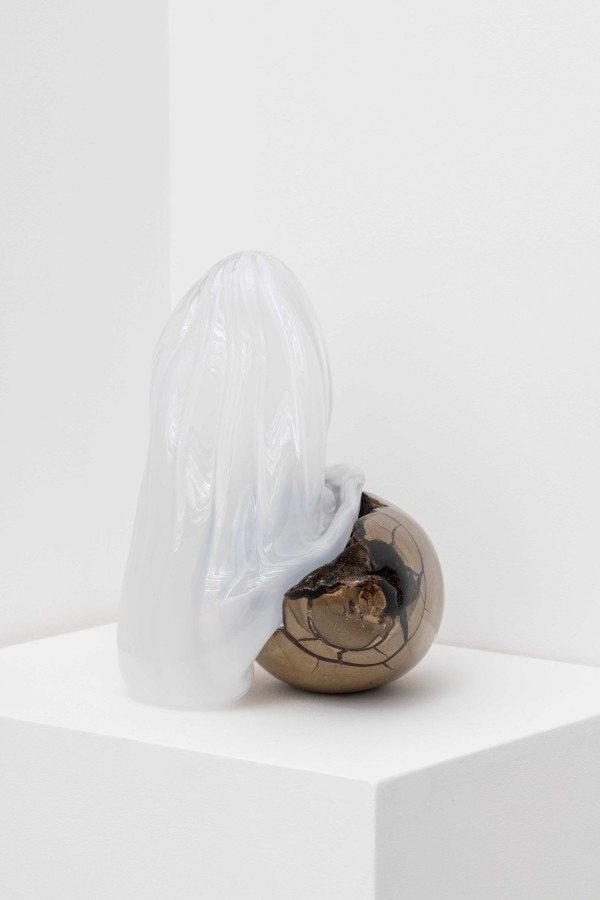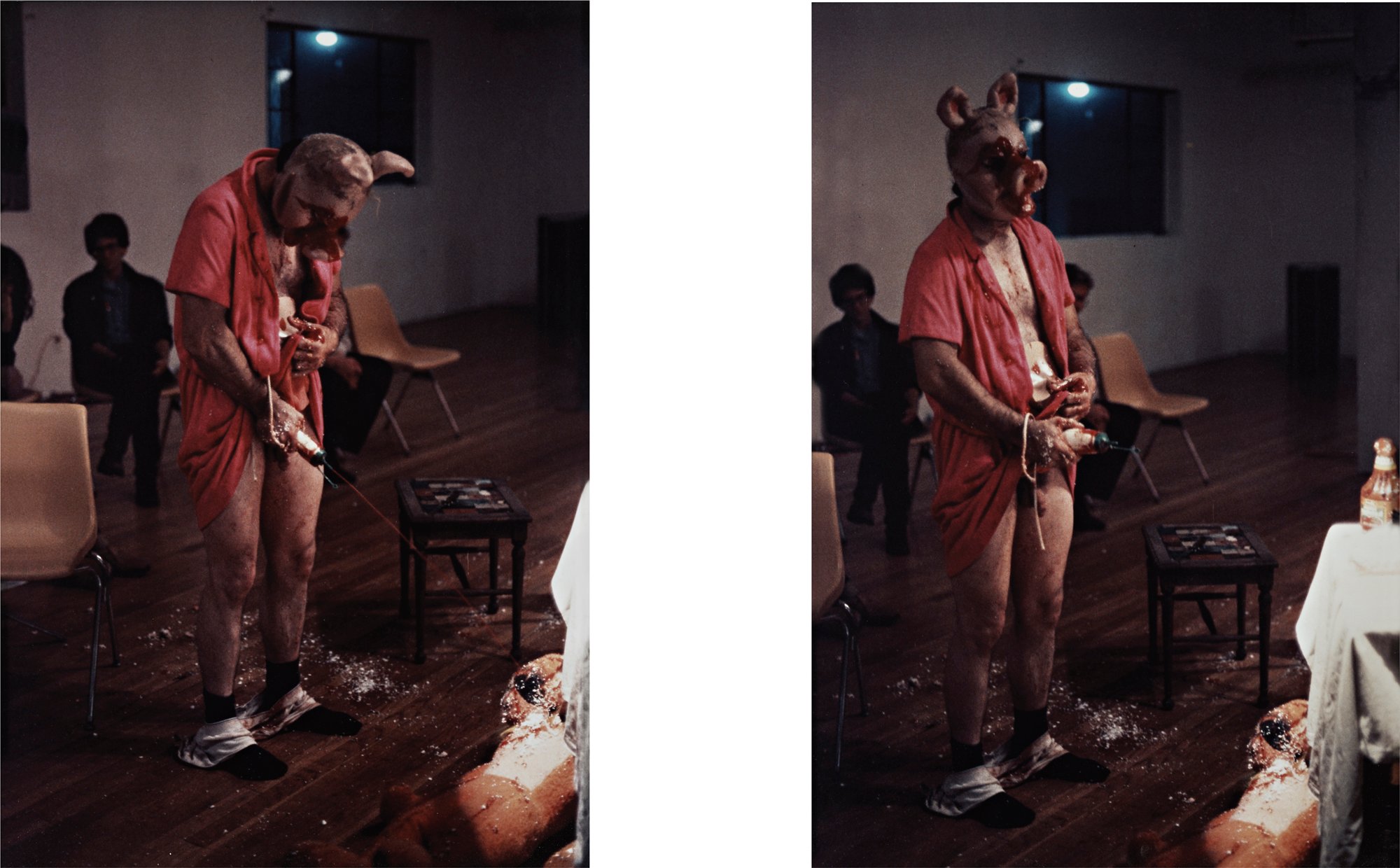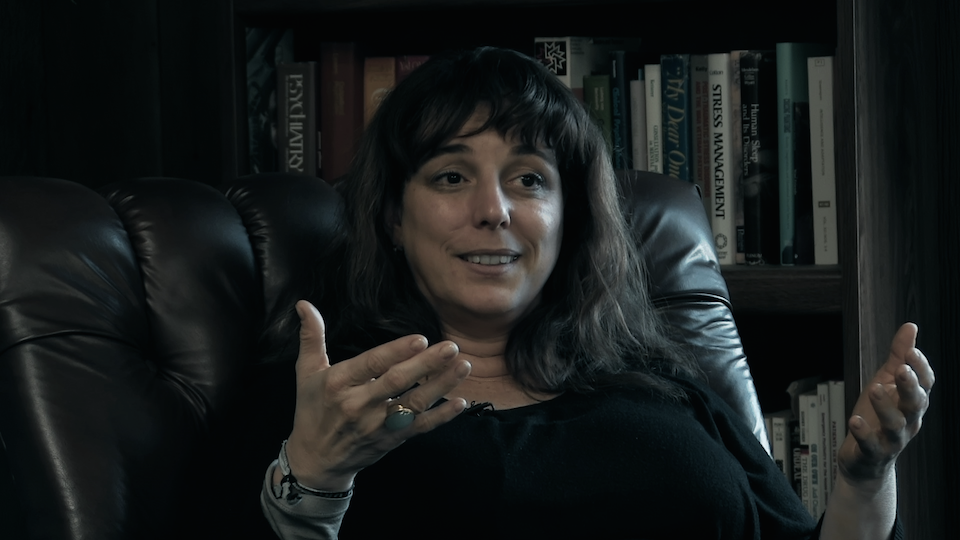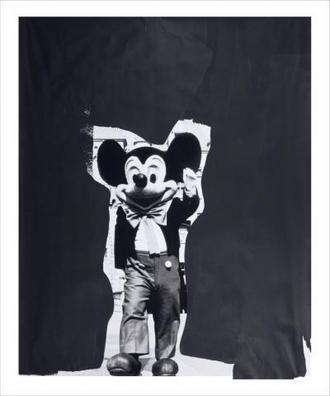
© » KADIST
Mary Reid Kelley
Priapus Agonistes by Mary Reid Kelley and Patrick Kelley is the first work in The Minotaur Trilogy (2013-2015), a trio of videos that reimagine the Greek myth of the Minotaur. The monstrous result of Queen Pasiphae’s infatuation with a bull, the Minotaur lived in a huge maze known as the Labyrinth where he would devour sacrificial offerings of youths and maidens. Traditionally, the story centers on Theseus and his heroic (and successful) quest to conquer the Minotaur, subsequently freeing the people of Athens from their obligations.

© » KADIST
Rachel Rose
First Born by Rachel Rose is part of a series of works titled Borns which expands on the artist’s longstanding interest in the organic shape of eggs. For this sculpture made of rock and glass the artist has created a milky glass-blown shape, almost like fabric in its form, which is draped over a metallic rock in the shape of an egg. For the artist, the egg is an alchemical symbol that is representative of conception and birth.

© » KADIST
John Menick
The theme of the end of the world, of the last man on earth, recurs in our literary and cinematographic culture and in our imaginary: “we had this dream before, the dream that we’re alone.” In The Secret Life of Things , the narrator presents himself as an enthusiast and expert on films announcing the end of the world and those staging someone waking up to discover that they are the only survivor on earth. Like in some works by Mario Garcia Torres (like The Transparencies of the Non-Act , a slide projection about the artist Oscar Neuestern, Kadist Collection), the artist lends his discourse to a stranger. Mastering the montage, he intersperses a monologue and images.

© » KADIST
Mary Reid Kelley
In the video The Syphilis of Sisyphus (2011), Reid Kelley transported her heroine to the French demimonde. The film centers on a pregnant Parisian prostitute who exemplifies Baudelaire’s paean to the superiority of cosmetic over natural beauty. With sets that shift between Sisyphus’s boudoir and the streets of Paris, the work is an antic romp through Revolutionary and post Revolutionary France, with brief vignettes involving everyone from Diderot, Marie Antoinette, and Marat to Robespierre, Napoleon, and Haussmann.

© » KADIST
Mary Reid Kelley
Situated in German-occupied Belgium at the end of World War I, Y ou Make Me Iliad by Mary Reid Kelley focuses on the story of two. characters: a Belgian prostitute working near the frontlines and a young German soldier charged with monitoring the brothels. Harboring literary aspirations, the soldier goes in search of material to complete his novel.

© » KADIST
Mary Reid Kelley
Kelley’s 2015 portrait of the poet Charles Baudelaire is one of a series of poets, rappers, and other thinkers who have influenced the artist’s ideas about beauty, creativity, and expression. As a challenging artist who marches to her own drum, Mary Reid Kelley is in the vanguard of a generation that blends the digital and the analog to dialogue with history. From 2009 to the present, she has made videos that fuse live performance, animation, drawing, sculpture, and digital design.

© » KADIST
Euan Macdonald
The video 9000 PIECES by Euan Macdonald was filmed at a musical instrument factory in Shanghai where 90 percent of the pianos that they manufacture are exported around the world, and only 10 percent are “finished” and can be labeled “Made in the US (or) Europe.” The video captures an intricate network of mechanisms as they interact with each other, their rhythmic movements resulting in an intense choreography and a cacophony of metallic sounds dramatized by Macdonald’s editing. As the shot widens it reveals the process we see unfold: a piano being vigorously tested by a factory machine designed to determine the endurance of the instruments. Contrary to what is often relayed, the work has nothing to do with Chinese factories or fast changing global economies.

© » KADIST
Felipe Dulzaides
I Am Cuba— “Soy Cuba” in Spanish; “Ya Kuba” in Russian—is a Soviet/Cuban film produced in 1964 by director Mikhail Kalatozov at Mosfilm. The movie was not well received by the Russian or Cuban public and was almost completely forgotten until its rediscovery thirty years later by American filmmakers. The movie’s acrobatic tracking shots and idiosyncratic mise-en-scène prompted Hollywood directors like Martin Scorsese to campaign to restore the movie in the early 1990s.

© » KADIST
Sadie Benning
In borrowing and subverting images from popular culture, Sadie Benning exposes the media’s role in constructing false and oppressive stereotypes of women, with regard to gender and sexual identity. This small painting, titled Mom , is a concise, eloquent visual statement. Many of her paintings incorporate found imagery, family photos, and everyday objects.

© » KADIST
Rachel Rose
In the 2013 video work, Sitting Feeding Sleeping , Rose combines footage taken of zoo animals living in captivity with screen images that flicker and flash before us. In the narration, Rose talks about forms of life that are suspended and simulated—artificial intelligence and cryogenically frozen bodies, zoo animals and counterfeit ecologies. Through this montage of different types of footage and text, Rose poses us between the natural and the artificial, and speaks to the very strange moment of life in a world that is seemingly caught between the two, existing in a hybrid (though not necessarily symbiotic) moment of radical change.

© » KADIST
Rachel Rose
A minute Ago starts with a hailstorm pelting down unexpectedly on a quiet beach in Siberia. People, half naked, run for cover under towels and parasols, to the music of the Pink Floyd. The next scene is an interview of Philip Johnson, filmed 10 years before in the Glass House he constructed.

© » KADIST
Sergio De La Torre
Nuevo Dragon City is a reenactment of a historical event from 1927 in which six Chinese were either trapped or voluntarily hid themselves inside a building in northern Mexico. Working with this unsettled mystery, De La Torre’s video inquires into the historical and continuing tensions between Chinese and Mexicans. As such, Nuevo Dragon City depicts a symbolic act of self-entrapment in which six untrained actors of Chinese descent silently blockade themselves inside in an empty Tijuana storefront.

© » KADIST
Paul McCarthy
McCarthy’s Mother Pig performance at Shushi Gallery in 1983 was the first time he used a set, a practice which came to characterize his later works. Here, McCarthy squirts liquid out of a bottle held near his crotch onto a stuffed animal in the shape of a lion. The costuming, materials, and simulated bodily functions frequently appear in McCarthy’s work, which often disturbingly juxtaposes visceral and startling manipulation of the body with the cheerful artifacts of popular consumer culture.

© » KADIST
Lynn Hershman Leeson
Hershman Leeson’s documentary, Women Art Revolution (W. A. R.) draws from hundreds of hours of intimate interviews with her contemporaries—visionary artists, historians, curators and critics—who recount their fight to break down the barriers facing women both in the art world and society at large. The film features an original score by Carrie Brownstein, formerly of the band Sleater-Kinney.

© » KADIST
Brian Bress
Blindseye Arranger (Max) (2013) features a greyscale arrangement of rudimentary shapes layered atop one another like a dense cluster of wood block prints, the juxtaposition of sharp lines and acute angles creating an abstracted field of rectangular and triangulated forms composed as if in a cubist landscape. As the video progresses, however, a disembodied hand begins to move these forms, animating a pictorial frame that was previously still. The hand – ostensibly the “arranger” of the works title – functions as a metonym of the artist’s hand, quite literally bringing a motionless work to life.

© » KADIST
Lynn Hershman Leeson
Tania Libre is a film by Lynn Hershman Leeson centered around renowned artist Tania Bruguera and her experience as a political artist and activist under the repressive government of her native Cuba. The film begins with the voice of Tilda Swinton narrating a manifesto of artists’ rights written by Bruguera in which she expresses her views on art, our universal right to both enjoy and create art, and the duty that artists have to dissent. The film then captures a series of therapy sessions between Bruguera and Dr. Frank M. Ochberg—the founding father of trauma therapy, particularly PTSD and Stockholm Syndrome—where Bruguera describes with great candor and earnestness several traumatic experiences such as the betrayal by her father who handed her to Cuban secret service, and her imprisonment in Havana years later after advocating for freedom of expression.

© » KADIST
Doug Aitken
The version of Frontier acquired by the Kadist Collection consists of a single-channel video, adapted from the monumental installation and performance that Aitken presented in Rome, by the Tiber River, in 2009. In this film, Aiken’s allusion to “the frontier” and iconic imagery like the cowboy suggest that the American West Coast as a cultural construction. These notions are reinforced by two key elements in the film: its protagonist, the iconic West Coast artist Ed Ruscha, and its reference to the cinematic and the experience of the movie theater.

© » KADIST
Lynn Hershman Leeson
Lynn Hershman Leeson’s genre-bending documentary Strange Culture tells the story of how one man’s personal tragedy turns into persecution by a paranoid, conservative, and overzealous government. Through interviews, scripted acting, and illustrations, Hershman Leeson outlines the series of absurd events that led to New York state’s case against the former SFAI Associate Professor and artist Steve Kurtz. By closely following Kurtz’s story, Hershman Leeson reveals a strange ripple effect of the Bush administration’s destructive policies.

© » KADIST
Sergio De La Torre
This is not in Spanish looks at the ways in which the Chinese population in Mexico navigates the daily marginalization they encounter there. The neon translates as “this is not in Spanish,” making reference to both the famous Rene Magritte painting “Ceci n’est pas une pipe” as well as signs posted in the windows of Chinese establishments in Mexico.

© » KADIST
Lynn Hershman Leeson
Using the seminal 1958 film Vertigo as a launchpad, Lynn Hershman Leeson explores the blurred lines between fact and fantasy in VertiGhost , a film commissioned by the Fine Arts Museums in San Francisco. VertiGhost features the re-creation of select scenes from Vertigo (which takes place in San Francisco), documentation of the life of a painting by Amedeo Modigliani in the Legion of Honor’s collection that was enshrouded by questions of authenticity, as well as interviews—including with the original film’s star Kim Novak— about the construction of realities in life and art. By thoughtfully overlaying these conversations and events, Hershman Leeson distills complex conversations around identity and authenticity into concise insights in just over 12 minutes.

© » KADIST
Paul McCarthy
Memory Mistake of the Eldridge Cleaver Pants was created for the show Paul McCarthy’s Low Life Slow Life Part 1 , held at California College of the Arts’s Wattis Institute in 2008 and curated by McCarthy himself. In homage to an influence in his early career, McCarthy attempted to reconstruct a pair of pants worn by Black Panther revolutionary Eldridge Cleaver in a picture that appeared in Rolling Stone magazine in the 1970s. But in the process, McCarthy misremembered their original design of the pants, which had black outer panels and white inner panels in white, and left a black shape highlighted in the crotch area.

© » KADIST
Tony Oursler
Continuing Oursler’s broader exploration of the moving image, Absentia is one of three micro-scale installations that incorporate small objects and tiny video projections within a miniature active proscenium. Mounted on platforms suspended in space on metal stands, the video sculpture contemplates human relationships, expressed here by shouts and murmurs, the strange and the familiar.

© » KADIST
Paul McCarthy
Drawing & Print (Drawing & Print)
To make Mickey Mouse (2010), Paul McCarthy altered a found photograph—not of the iconic cartoon, but of a man costumed as Mickey. On his shoulders he supports an enormous false head, Mickey’s familiar face grinning with glossy eyes. The artist has marked out in heavy black the background of Cinderella’s castle.
Lynn Hershman Leeson
- location: San Francisco, California
- year born: 1941
- gender: female
- nationality: American
- home town: Cleveland, Ohio
Paul McCarthy
- location: Los Angeles, California
- year born: 1945
- gender: male
- nationality: American
- home town: Salt Lake City, Utah
Mary Reid Kelley
Drawing from literature, plays, and historical events, Mary Reid Kelley makes rambunctious videos that explore the condition of women throughout history...
Rachel Rose
Rachel Rose is a visual artist known for her video installations that merge moving images and sound within nuanced environments connecting them to broader subjects...
Sergio De La Torre
Sergio De La Torre has worked with and documented the manifold ways in which citizens reinvent themselves in the city they inhabit, as well as the site-specific strategies they deploy to move “in and out modernity.” De La Torre often collaborates with his subjects, resulting in both intimate and critical reflections on topics like housing, immigration, and labor...
John Menick
Rather like the narrator in the video belonging to the Kadist collection, The secret life of things, the artist John Menick is a ‘professional spectator’...
Euan Macdonald
Euan Macdonald’s videos, drawings and sculptures are informed by a wide array of philosophical, musical, and literary references, but return repeatedly to the quotidian occurrence, the everyday as subject...
Felipe Dulzaides
Felipe Dulzaides studied drama at the Instituto Superior de Arte of Havana and received a MFA in New Genres from the San Francisco Art Institute...
Tony Oursler
- year born: 1957
- gender: male
- nationality: American
- home town: New York, New York
Brian Bress
- location: Los Angeles, California
- year born: 1975
- gender: male
- nationality: American
- home town: Norfolk, Virginia
Doug Aitken
- year born: 1968
- gender: male
- nationality: American
- home town: Redondo Beach, California
Sadie Benning
When she was fifteen Sadie Benning’s father gave her a kiddie PixelVision camera, a device that recorded grainy black-and-white video on standard audio cassettes...
-
1980-1989
Paul McCarthy
1983McCarthy’s Mother Pig performance at Shushi Gallery in 1983 was the first time he used a set, a practice which came to characterize his later works...
-
-
2000-2009
John Menick
2006The theme of the end of the world, of the last man on earth, recurs in our literary and cinematographic culture and in our imaginary: “we had this dream before, the dream that we’re alone.” In The Secret Life of Things , the narrator presents himself as an enthusiast and expert on films announcing the end of the world and those staging someone waking up to discover that they are the only survivor on earth...
Felipe Dulzaides
2006I Am Cuba— “Soy Cuba” in Spanish; “Ya Kuba” in Russian—is a Soviet/Cuban film produced in 1964 by director Mikhail Kalatozov at Mosfilm...
Lynn Hershman Leeson
2007Lynn Hershman Leeson’s genre-bending documentary Strange Culture tells the story of how one man’s personal tragedy turns into persecution by a paranoid, conservative, and overzealous government...
Sergio De La Torre
2008Nuevo Dragon City is a reenactment of a historical event from 1927 in which six Chinese were either trapped or voluntarily hid themselves inside a building in northern Mexico...
Paul McCarthy
2008Memory Mistake of the Eldridge Cleaver Pants was created for the show Paul McCarthy’s Low Life Slow Life Part 1 , held at California College of the Arts’s Wattis Institute in 2008 and curated by McCarthy himself...
Doug Aitken
2009The version of Frontier acquired by the Kadist Collection consists of a single-channel video, adapted from the monumental installation and performance that Aitken presented in Rome, by the Tiber River, in 2009...
-
2010-2019
Mary Reid Kelley
2010Situated in German-occupied Belgium at the end of World War I, Y ou Make Me Iliad by Mary Reid Kelley focuses on the story of two...
Euan Macdonald
2010The video 9000 PIECES by Euan Macdonald was filmed at a musical instrument factory in Shanghai where 90 percent of the pianos that they manufacture are exported around the world, and only 10 percent are “finished” and can be labeled “Made in the US (or) Europe.” The video captures an intricate network of mechanisms as they interact with each other, their rhythmic movements resulting in an intense choreography and a cacophony of metallic sounds dramatized by Macdonald’s editing...
Paul McCarthy
Drawing & Print
2010(Drawing & Print) To make Mickey Mouse (2010), Paul McCarthy altered a found photograph—not of the iconic cartoon, but of a man costumed as Mickey...
Mary Reid Kelley
2011In the video The Syphilis of Sisyphus (2011), Reid Kelley transported her heroine to the French demimonde...
Sergio De La Torre
2011This is not in Spanish looks at the ways in which the Chinese population in Mexico navigates the daily marginalization they encounter there...
Tony Oursler
2012Continuing Oursler’s broader exploration of the moving image, Absentia is one of three micro-scale installations that incorporate small objects and tiny video projections within a miniature active proscenium...
Mary Reid Kelley
2013Priapus Agonistes by Mary Reid Kelley and Patrick Kelley is the first work in The Minotaur Trilogy (2013-2015), a trio of videos that reimagine the Greek myth of the Minotaur...
Rachel Rose
2013In the 2013 video work, Sitting Feeding Sleeping , Rose combines footage taken of zoo animals living in captivity with screen images that flicker and flash before us...
Brian Bress
2013Blindseye Arranger (Max) (2013) features a greyscale arrangement of rudimentary shapes layered atop one another like a dense cluster of wood block prints, the juxtaposition of sharp lines and acute angles creating an abstracted field of rectangular and triangulated forms composed as if in a cubist landscape...
Rachel Rose
2014A minute Ago starts with a hailstorm pelting down unexpectedly on a quiet beach in Siberia...
Mary Reid Kelley
2015Kelley’s 2015 portrait of the poet Charles Baudelaire is one of a series of poets, rappers, and other thinkers who have influenced the artist’s ideas about beauty, creativity, and expression...
Lynn Hershman Leeson
2016Tania Libre is a film by Lynn Hershman Leeson centered around renowned artist Tania Bruguera and her experience as a political artist and activist under the repressive government of her native Cuba...
Sadie Benning
2017In borrowing and subverting images from popular culture, Sadie Benning exposes the media’s role in constructing false and oppressive stereotypes of women, with regard to gender and sexual identity...
Lynn Hershman Leeson
2017Using the seminal 1958 film Vertigo as a launchpad, Lynn Hershman Leeson explores the blurred lines between fact and fantasy in VertiGhost , a film commissioned by the Fine Arts Museums in San Francisco...
Rachel Rose
2019First Born by Rachel Rose is part of a series of works titled Borns which expands on the artist’s longstanding interest in the organic shape of eggs...
